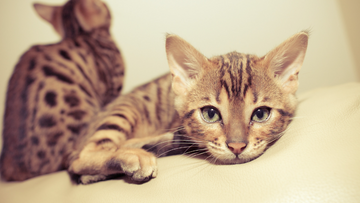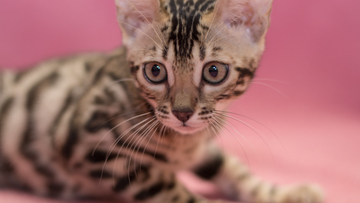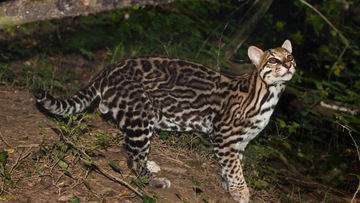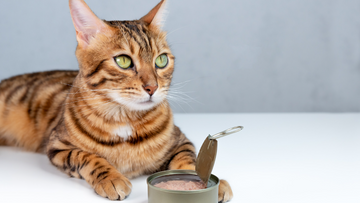Feline immunodeficiency virus (FIV)
In infected cats, Feline Immunodeficiency Virus (FIV) attacks the immune system, leaving the cat vulnerable to many other infections. Although cats infected with FIV may appear normal for years, they eventually suffer from this immune deficiency, which allows normally harmless bacteria, viruses, protozoa, and fungi found in the everyday environment to potentially cause severe illnesses. The median survival time for a cat diagnosed with FIV is approximately five years.
FIV-infected cats are found worldwide, but the prevalence of infection varies greatly. In the United States, approximately 1.5 to 3 percent of healthy cats are infected with FIV. Rates are significantly higher (15 percent or more) in cats that are sick or at high risk of infection. Because biting is the most efficient means of viral transmission, free-roaming, aggressive male cats are the most frequently infected, while cats housed exclusively indoors are much less likely to be infected.
The primary mode of transmission for FIV is through bite wounds. Casual, non-aggressive contact does not appear to be an efficient route of spreading the virus. As a result, cats in households with stable social structures where housemates do not fight are at little risk of acquiring FIV infections. On rare occasions infection is transmitted from an infected mother cat to her kittens, usually during passage through the birth canal or when the newborn kittens ingest infected milk. Sexual contact is not a major means of spreading FIV.
Many people confuse FIV with Feline Leukemia Virus (FeLV). Although these diseases are in the same retrovirus family and cause many similar secondary conditions FeLV and FIV are different diseases.
CLINICAL SIGNS
Early in the course of infection, the virus is carried to nearby lymph nodes, where it reproduces in white blood cells known as T-lymphocytes. The virus then spreads to other lymph nodes throughout the body, resulting in a generalized but usually temporary enlargement of the lymph nodes, often accompanied by fever. This stage of infection may pass unnoticed unless the lymph nodes are greatly enlarged.
An infected cat's health may deteriorate progressively or be characterized by recurrent illness interspersed with periods of relative health. Sometimes not appearing for years after infection, signs of immunodeficiency can appear anywhere throughout the body.
 Poor coat condition and persistent fever with a loss of appetite are common in infected cats. Inflammation of the gums (gingivitis) and mouth (stomatitis) and chronic or recurrent infections of the skin, eyes, urinary bladder, and upper respiratory tract are often present. Persistent diarrhea can also be a problem, as can a variety of eye conditions. Some infected cats experience seizures, behavior changes, and other neurological disorders.
Poor coat condition and persistent fever with a loss of appetite are common in infected cats. Inflammation of the gums (gingivitis) and mouth (stomatitis) and chronic or recurrent infections of the skin, eyes, urinary bladder, and upper respiratory tract are often present. Persistent diarrhea can also be a problem, as can a variety of eye conditions. Some infected cats experience seizures, behavior changes, and other neurological disorders.
Slow but progressive weight loss is common in cats with FIV, often followed by severe wasting late in the disease process. Several kinds of cancer and blood diseases are much more common in affected cats.
FIV infection sometimes leads to gingivitis, painful inflammation of the gums.
DIAGNOSIS
To diagnose FIV infection, blood samples are examined for the presence of antibodies to the FIV virus. FIV antibodies can be detected using a number of techniques, including enzyme-linked immunosorbent assay (ELISA), western blot, and immunofluorescence (IFA) assays. These techniques are dependent upon the host cat mounting an immune response to FIV virus. If a host cat has not had sufficient time after exposure to mount an immune response or if the host cannot mount an immune response due to immunosuppression, antibodies may not be detected in a cat that is actually infected with FIV.
POSITIVE RESULTS
Because few, if any, cats ever eliminate infection, the presence of antibodies indicates that a cat is infected with FIV. This test can be performed by most veterinary diagnostic laboratories and also is available in kit form for use in veterinary clinics. Since false-positive results may occur, veterinarians recommend that positive results be confirmed using a test with a different format.
Infected mother cats transfer FIV antibodies to nursing kittens, so kittens born to infected mothers may receive positive test results for several months after birth. However, few of these kittens actually are or will become infected. To clarify their infection status, kittens younger than six months of age that test positive for FIV should be retested at 60-day intervals until they are at least six months old.
FIV vaccines cause a vaccinated cat to produce antibodies against the FIV virus that can be difficult to distinguish from those produced by a cat in response to natural infection with FIV. For this reason, it is necessary to know a cat’s FIV vaccination history (where possible) in order to accurately interpret test results.
NEGATIVE RESULTS
A negative test result indicates that the cat’s body has not produced antibodies directed against FIV. In most cases, this suggests that a cat is not infected. However, it usually takes eight to 12 weeks after infection for detectable levels of antibody to appear in the bloodstream, so testing performed during this interval may result in false negative results. Therefore, antibody-negative cats that have had contact with a cat that is either infected with FIV or has an unknown FIV status, such as through the bite of an unknown cat, should be retested a minimum of 60 days after their most recent exposure. This allows the cat’s body time to develop antibodies to the virus.
On very rare occasions, cats in the later stages of FIV infection may test negative on FIV antibody tests because their immune systems are so compromised that they no longer produce detectable levels of antibody.
Polymerase chain reaction (PCR) tests are designed to detect short segments of a virus's genetic material. This test does not rely upon the detection of antibodies to FIV that are produced by the host cat, but rather tests for the presence of the FIV virus itself (by detecting viral DNA). While antibody-based tests are ideal screening tests for infection, in certain situations (such as confirming infection in antibody-positive kittens or determining infection of cats vaccinated with antibody-eliciting FIV vaccines), PCR-based tests are theoretically superior. Although PCR testing methods offer promise, these techniques result in relatively high numbers of false-positive and false-negative results, so they are not routinely being recommended. Recent advances in this technology, however, have prompted hope that PCR based techniques may eventually improve our ability to accurately diagnose FIV.
TREATMENT/MANAGEMENT/PROGNOSIS
Unfortunately, there is currently no definitive cure for FIV. It is important to realize, however, that while it is impossible to predict the survival of a given cat infected with FIV, cats infected with FIV can live ostensibly normal lives for years if managed appropriately. Once an FIV infected cat has experienced one or more severe illnesses as a result of infection, however, or if persistent fever and weight loss are present, the prognosis is generally less favorable.
FIV-infected cats should be spayed/neutered and should be confined indoors to prevent spread of FIV infection to other cats in the neighborhood and to reduce their exposure to infectious agents carried by other animals. They should be fed nutritionally complete and balanced diets, and uncooked food, such as raw meat and eggs, and unpasteurized dairy products should be avoided to minimize the risk of food-borne bacterial and parasitic infections.
Wellness visits for FIV-infected cats should be scheduled at least every six months. A detailed physical examination of all body systems will be performed by your veterinarian with special attention to the health of the gums, eyes, skin, and lymph nodes. Your cat's weight will be measured accurately and recorded, because weight loss is often the first sign of deterioration. A complete blood count, serum biochemical analysis, and a urine analysis should be performed annually.
Vigilance and close monitoring of the health and behavior of FIV-infected cats is even more important than it is for uninfected cats. Alert your veterinarian to any changes in your cat's health as soon as possible.
While some antiviral therapies have been shown to benefit some FIV-infected cats with seizures or stomatitis (inflammation of the oral cavity) and to decrease the amount of virus that they shed into the environment, there is no definitive evidence that any antiviral therapy will prolong the lives of cats with FIV. The development of effective treatment options for FIV is the subject of significant research.
PREVENTION
The only sure way to protect cats is to prevent their exposure to the virus. Cat bites are the major means by which infection is transmitted, so keeping cats indoors, away from potentially infected cats that might bite them, markedly reduces their likelihood of contracting FIV infection. To reduce the chance of indoor cats becoming infected, it is ideal to assure that only infection-free cats are brought into a household occupied by uninfected cats. In some cases, separation of infected from non-infected cats is possible in a household, and this is ideal if infected cats must be brought into occupied by non-infected cats.
Unfortunately, many FIV-infected cats are not diagnosed until after they have lived for years with other cats. In such cases, all the other cats in the household should be tested. Ideally, all infected cats should be separated from the noninfected ones to eliminate the potential for FIV transmission. It is important to realize, however, that since FIV is transmitted primarily by bite wounds, transmission from an infected cat to an uninfected cat is much less likely in households that have stable social structures (i.e. households in which cats do not fight).
FIV will not survive for more than a few hours in most environments. However, FIV-infected cats are frequently infected with other infectious agents that may pose some threat to a newcomer. For these reasons, to minimize transmission of FIV and/or other infectious diseases to a cat that is brought into an environment in which an FIV-positive cat has lived, prudence dictates a thorough cleaning and disinfection or replacement of food and water dishes, bedding, litter pans, and toys. A dilute solution of household bleach (four ounces of bleach in 1 gallon of water) makes an excellent disinfectant. Vacuuming carpets and mopping floors with an appropriate cleanser is also recommended. Any new cats or kittens should be properly vaccinated against other infectious agents before entering the household.
Vaccines to help protect against FIV infection are now available, although these are not considered core vaccines for cats. Not all vaccinated cats will be protected by the vaccine, so preventing exposure is important, even for vaccinated cats. As discussed above, vaccination will impact future FIV test results, and any vaccination carries the risk of inducing vaccine–associated-sarcoma (a type of cancer) in cats, so it is important that you discuss the advantages and disadvantages of vaccination with your veterinarian to help you decide whether FIV vaccines should be administered to your cat.
HUMAN HEALTH CONCERNS
Although FIV is similar to HIV (the human immunodeficiency virus) and causes a feline disease that is similar to AIDS (acquired immune deficiency syndrome) in humans, it is a highly species-specific virus that infects only felines. There is currently no evidence that FIV can infect or cause disease in humans.
Can a Person Catch FIV from a Cat?
No. FIV cannot be transmitted from cat to human, only from cat to cat.







